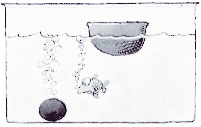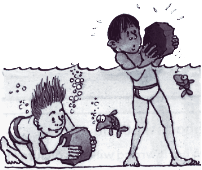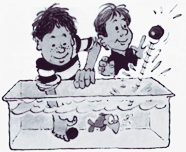|
Approach: Independent
|
| Focus:
Explain buoyancy and
flotation in three situations. |
 |
112k |
Resources:
None |
|
Questions / instructions:
Look at the pictures then
answer the questions.
Tirohia
ngä pikitia, kätahi ka whakautu i ngä pätai.
|
| |
|
|
%
responses
|
|
GEd
|
MI
|
|
1. Imagine that you have
a ball of plasticine. You put it in water and it sinks. Then you shape it into
a boat. Now it floats. Why did the ball of plasticine sink but the boat float?
Tënä
me pohewa noa he poi kerepëhi [ball of plasticine]
täu. Ka kuhuna e koe ki röto i te wai, ka totohu. Kia hangaia e koe
hei waka, kätahi ka mänu. He aha te poi kerepëhi i totohu ai, i
mänu kë ai ko te waka?
|
0
|
0
|

|
boat
shape displaces enough water to hold weight of plasticine
|
|
more
spread out so it floats/ water holds it up there
|
4
|
5
|
|
because
there is air inside it.
|
29
|
11
|
|
2. Why do things
feel lighter when you pick them up under water?
He
aha i mämä ake ai he mea ka hikina ana mai i raro i te wai?
|
2
|
5
|
 |
some
of the weight is supported by the water displaced
|
|
because
water is less dense than air
|
1
|
2
|
|
there
is less or no gravity under water
|
21
|
13
|
|
3. Someone
holds the ball at the bottom. Why does it jump out of the water when they let
it go?
Ka
pupuritia e tëtahi te poi ki raro. Kia tukua, nä te aha i peke ake ai
te poi?
|
1
|
0
|
 |
Under
the water: ball weighs less than the water displaced
|
|
air
in the ball makes it rise
|
43
|
36
|
|
Above
the water: ball moves upward because of inertia
|
0
|
0
|
|
ball
is going fast when it reaches the surface
|
3
|
0
|
Commentary:
This was a difficult task beyond the reach of most year 8 students. There was
not a statistically significant difference between GEd (General Education) and
MI (Mäori Immersion) students. |